Key Points
- Google’s Search Generative Experience (SGE) is a powerful example of an AI search engine and reveals where brand marketers need to go in order to keep up.
- SGE uses thousands of data points, pulled from live web pages, to create its sophisticated and valuable answers. Fortunately, brands can be part of the storytelling.
- Brands that build networks of owned assets through OAO provide SGE and future AI search engines with the content they need to tell their stories in brand-friendly ways.
Artificial intelligence-powered search engines have arrived, and it’s surprising just how intuitive and useful they are. Google Search Generative Experience (SGE) builds upon the search engine’s rich user experience, adding a generative search result stack to the SERPs.
As Google SGE moves into public release and wide adoption, brands must prepare and execute strategies to influence what SGE will say about them.
Here, we share how SGE works, the risks, and how the holistic owned asset optimization process provides added brand control in a sustainable, and ethical manner.
What is Google’s Search Generative Experience (SGE)?
Search Generative Experience is Google’s revolutionary AI search offering. It creates AI-generated answers to Google searches using publicly available, crawled web page content.
While SGE (as of January 2024) remains a so-called ‘experiment’ under Search Labs, it offers a revealing glimpse at the future of AI search and what Google will bring to market.
Why Google SGE matters
Each AI innovation promises to change the marketing landscape, but AI search is perhaps the most volatile area where tectonic shifts may occur. And, with Google controlling nearly all of the search market share, SGE is the one to watch and prepare for.
SGE should be a top priority for brand marketers as it poses risks and creates opportunities, much like OpenAI’s ChatGPT and similar AI offerings.
Generative search has implications for reputational defense and management, and adds even more to think about within the overall AI marketing space.
SGE brand risks:
- SGE is a new and prominent voice that can challenge brand narratives.
- SGE is not controlled, or controllable, in traditional ways.
- Like other AI tools, SGE can make mistakes.
- SGE may return unflattering results.
- When public, SGE will reach billions of eyes.
- SGE results can reflect negative news cycles.
- SGE relies on live web content.
SGE brand opportunities:
- SGE can become a strong brand narrative supporter.
- What SGE generates is authoritative for Google users.
- SGE allows brand-owned and brand-friendly content as sources.
- SGE can become an important asset in a brand’s OAO arsenal.
- SGE takes up major real estate on the search results page.
SGE in action
SGE’s user flow is minimal and intuitive, and we expect any full release to be even more feature-rich and intelligent.
As of now, SGE shares the search box with standard Google search. A user performs a search and gets the standard results. SGE then offers the option to generate a response to that search. You can also have it automatically generate results on top of the SERPs.
SGE creates a multi-paragraph answer on the left. At the bottom users can ask follow-ups or choose from suggested further questions.
On the right, SGE provides a carousel of various sources (live, crawled web pages and more) that were used to generate the answer. Users can visit these sources to see the specific content SGE relied on to create that answer.
Breakdown of SGE
As mentioned above, SGE has a number of components, and it’s worth examining each. Below we break down SGE with screenshots of a recent search.
For the sake of staying in the newsworthy AI space, we searched ‘OpenAI’ in this example.
Here’s a look at the overall results:
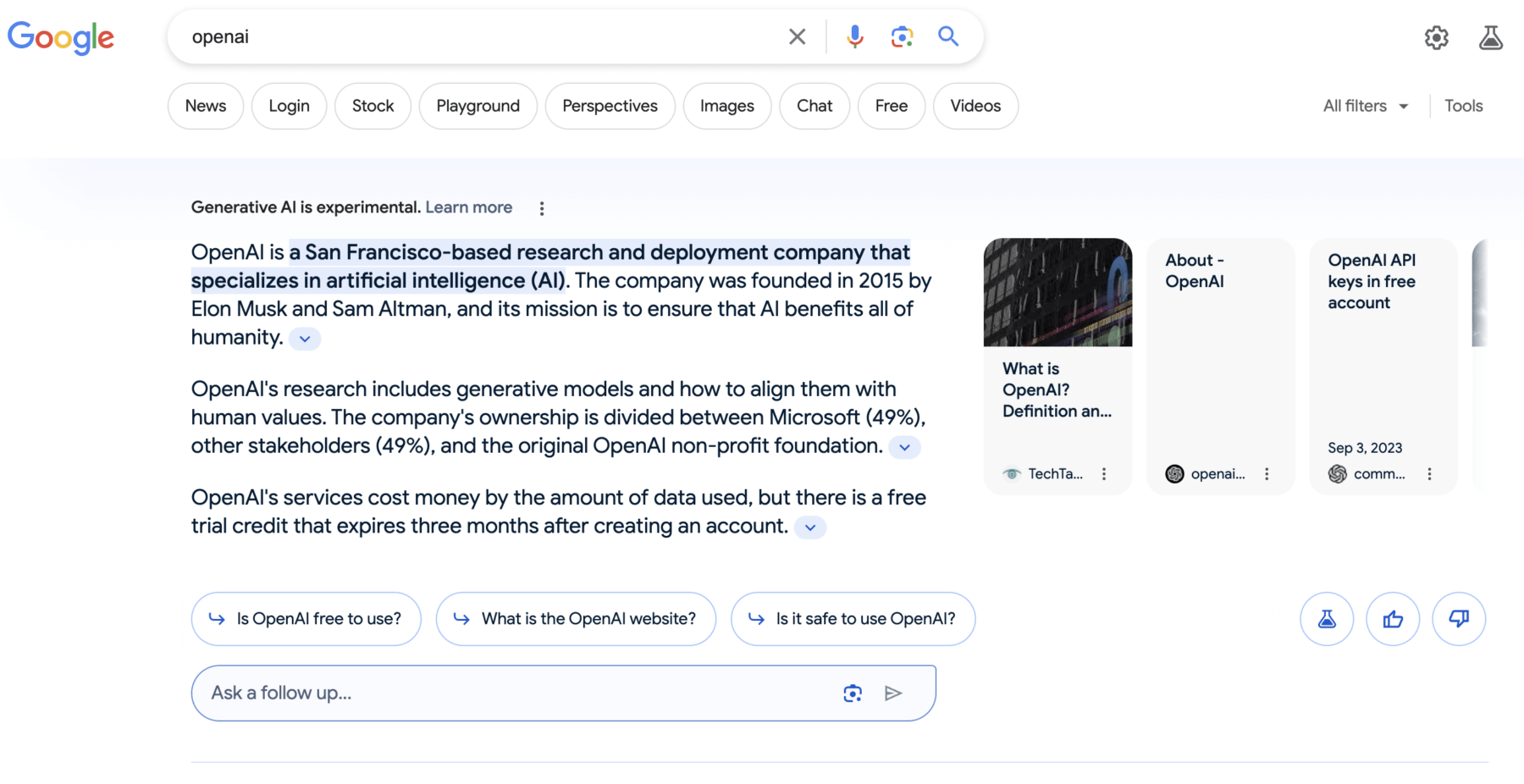
Answer to the query
SGE’s answer section provides fully AI-generated content and responds to any query, supplementing the SERPs with substantial written material. With many SGE searches, Google users may not need to even leave Google to get the answer they’re seeking. In this way, SGE produces remarkable value for its users and brands can add to that value.
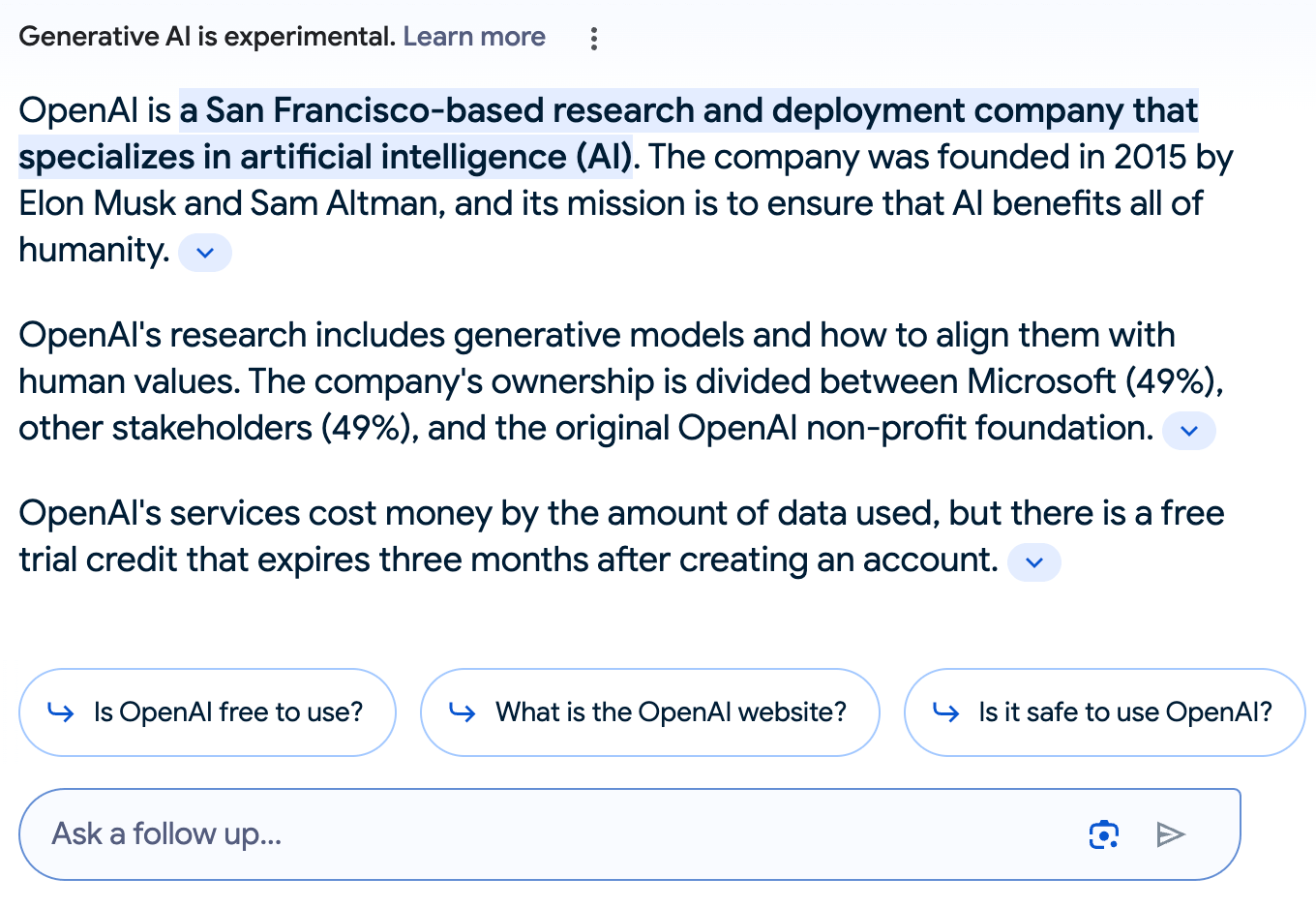
For brands, as shown in our example, SGE provides ‘what is’ content and then adds a number of other data points, company facts, and more to round out an answer. These answers reflect facts about brands but also change depending on factors such as negative news cycles, controversy, and reputation-damaging events.
After the answer content, SGE offers follow-up questions and a follow-up text box. Following these prompts, SGE tells an in-depth story about brands, digging deeper into the facts.
Brands need their own content to mitigate the risk that SGE generates unflattering, inaccurate, or harmful content. But it’s not about obscuring the truth, it’s about brands offering their narrative, across their assets, to better inform AI tools.
Sources
At this state, SGE does us the favor of showing exactly what it used to generate answers, unlike many other tools. With each answer, we get a convenient carousel and each tile represents a piece of the puzzle SGE uses to assemble the whole.
Our search used seven sources but each time you generate an answer, the content and sources are unique.
SGE uses a mixture of sources like Wikipedia, Google’s knowledge graph, news and media sites, social media, forums, and even brand-owned sources.
Also known as owned, managed, and leveraged assets, each source tells part of the story. As a networked whole, they become SGE’s story about your brand. Brands that invest heavily in their owned assets almost automatically begin building control and start influencing AI search in a positive, more accurate direction.
Example sources deep dive
Digging in a bit deeper, let’s take a look at some specific sources to get an idea of exactly what SGE used for our query. Here you’ll begin to see how brands can use their assets to create influence. Our recent SGE pull on OpenAI grabbed:
Source(s): OpenAI home page and About page
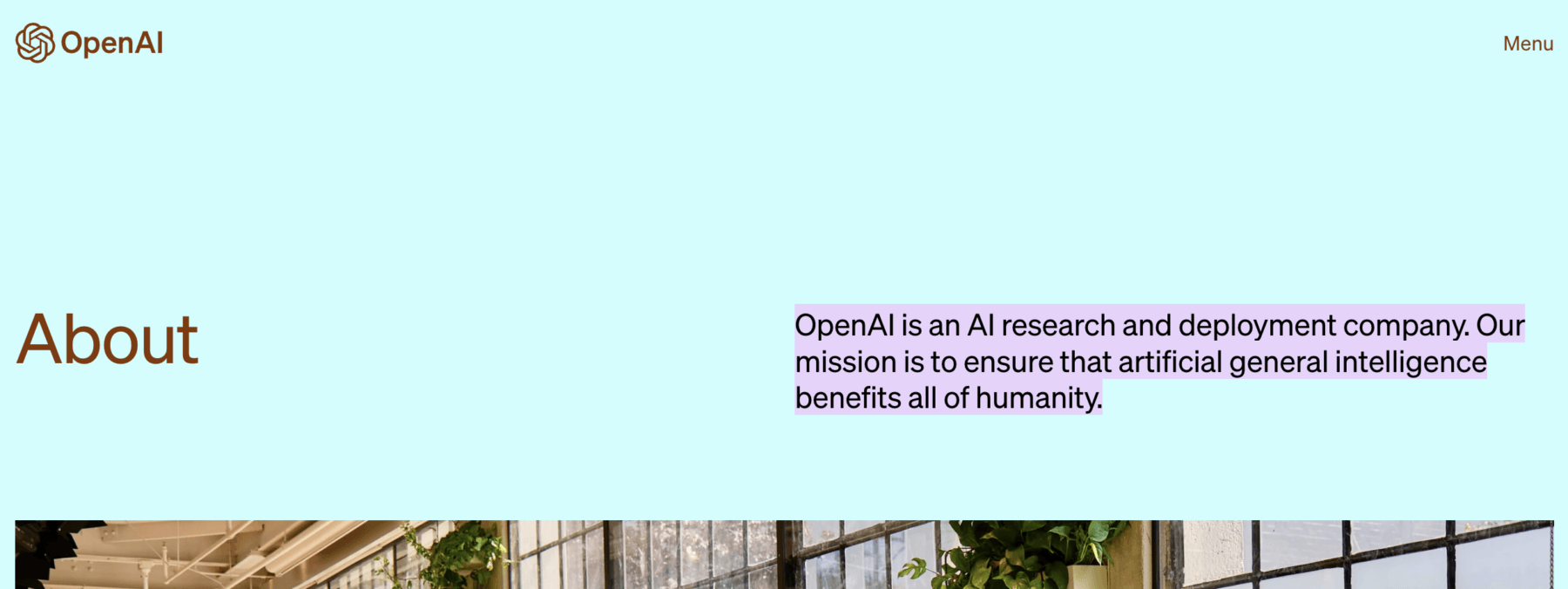
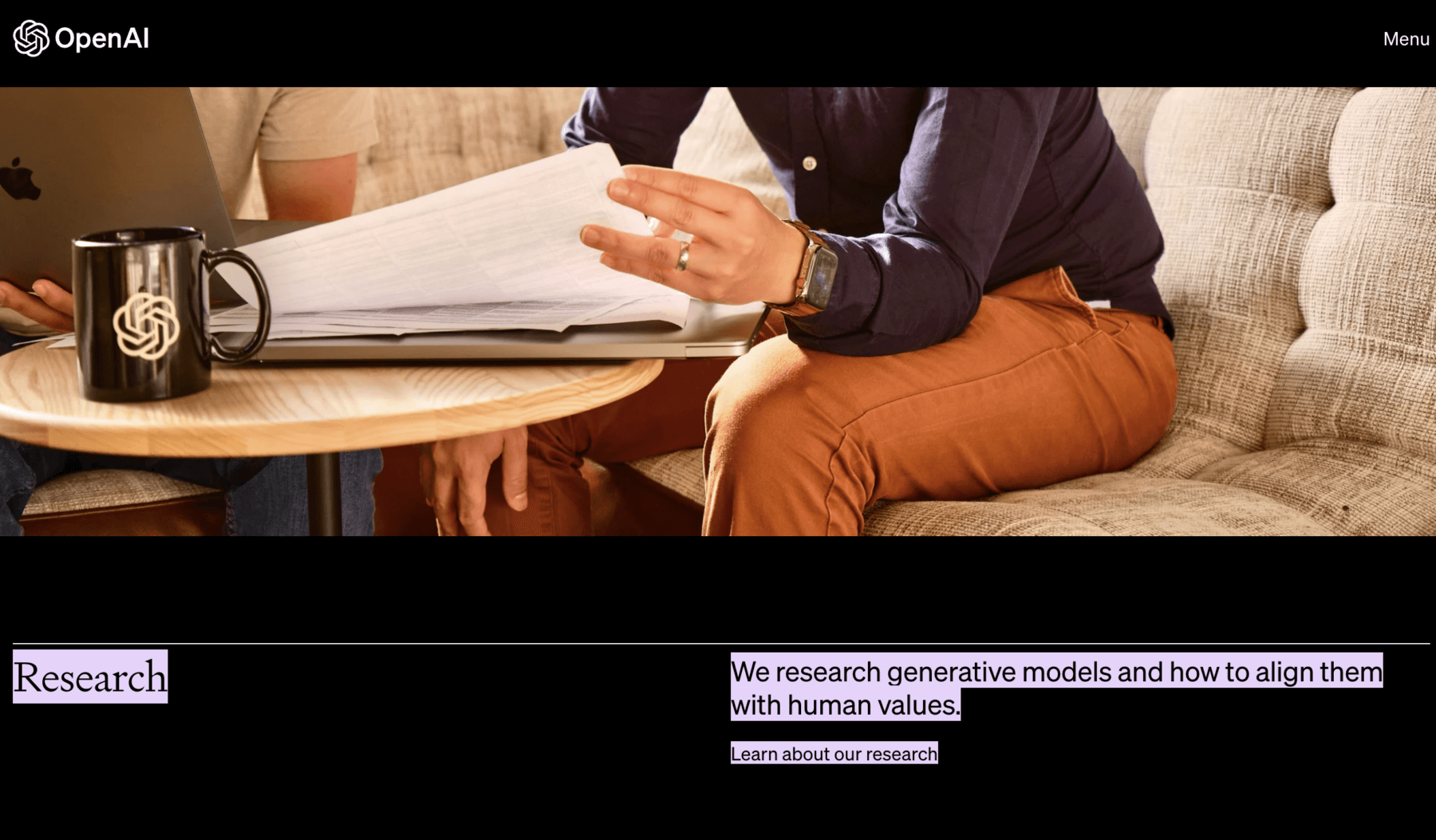
In creating our answer above, SGE uses snippets from two brand-controlled web pages, highlighting the importance of owned assets. If OpenAI didn’t have these two assets, SGE would have had to look elsewhere and may have sourced from a third party.
Building as many brand-owned assets as possible is the key to influencing SGE, and ensures that the brand’s position and narrative are parts of the AI’s story. Here, OpenAI has done so but certainly could do more to take control.
Source(s): OpenAI community forum post
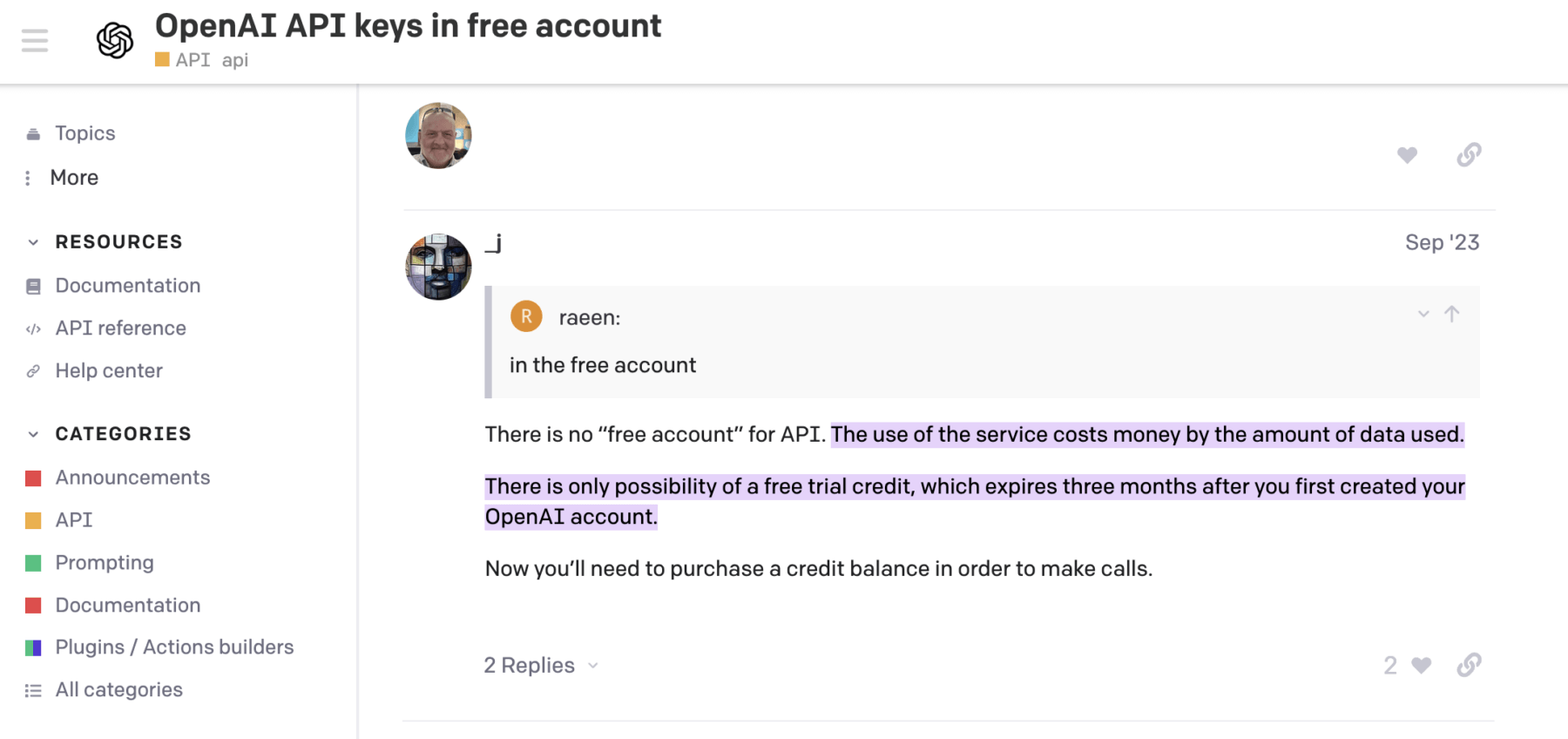
A testament to the power of SGE, it used an individual post on the OpenAI community forum to fill in some answer details. Not only does this show off the intelligence of SGE, but it also shows how even one small sentence on a site can influence AI search. Fortunately for OpenAI, SGE used another owned property.
Source(s): OpenAI’s LinkedIn

Moving into the social media space, SGE selected part of the OpenAI LinkedIn page about section to generate its answer. This further increases the diversity of sources and also speaks to the value of holding managed assets like LinkedIn or Glassdoor.
A previous SGE answer on ‘OpenAI’ pulled a post from X (formerly Twitter) that the company posted. As another managed asset, this shows that the opportunities to influence SGE at this tier are boundless.
Source(s): TechTarget listing and Techopedia listing
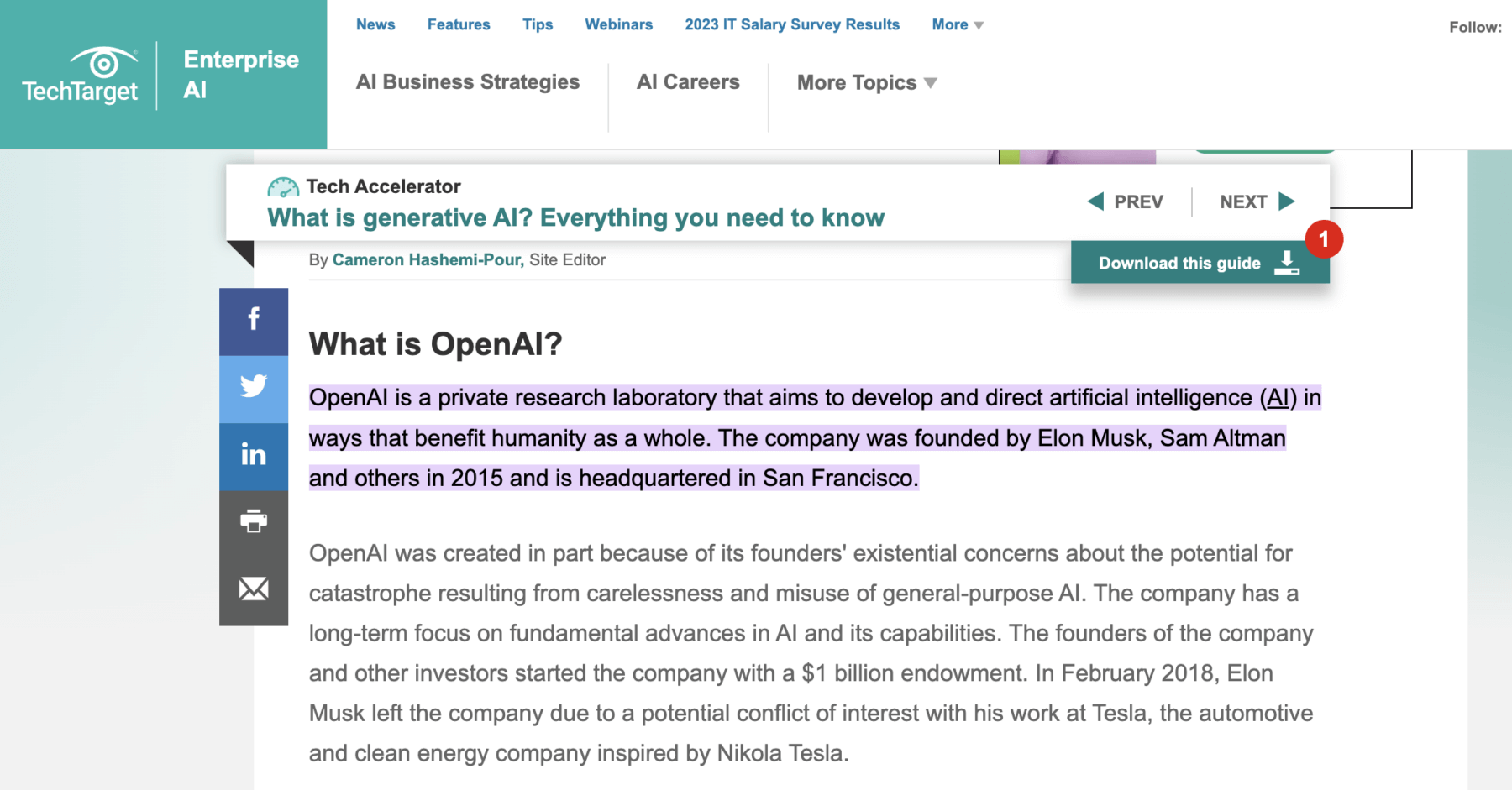

Third-party informational sites also appeared prominently in the source list, injecting a different (and wholly beyond brand control) perspective into SGE’s answer. Because these are non-brand sources, negative information they contain can make it to SGE.
This is often unavoidable but can be balanced out when brands offer their narrative directly through their own properties. Brands can work to proactively soften negative narratives.
Source(s): Business Insider article

As a perfect case-in-point, this Business Insider article takes on a cynical tone as it reports that, “OpenAI has quietly changed its core values, and being ‘thoughtful’ and ‘audacious’ no longer makes the cut.”
Does this actually reflect reality or mean OpenAI trashed its noble values? No. But can it reach SGE and damage the answer AI search provides millions of users? You bet.
Again, the need for myriad brand-owned content and assets couldn’t be clearer.
Influencing SGE results
Now that you made it through the SGE source deep dive, you’re probably wondering how your brand can defend against SGE’s risks, and turn its opportunities into wins.
It is worth noting that when we talk about influencing SGE, we’re actually talking about providing the human audience with as much value-rich content as possible aimed at solving their problems.
When you build exceptional content experiences for humans searching on Google, you’re automatically giving SGE what it wants so that it can better understand your brand. When SGE understands your brand it produces answers your audience can readily connect with.
Here’s what we recommend to get started:
1. Know where you stand
Ask SGE
The first thing is to get an idea of where you stand from SGE’s perspective. It’s as simple as performing some queries consumers might ask or search about your brand.
A few ideas to ask SGE to generate:
- Search your brand name.
- Search something like “Is [brand] legit?”
- Search around the specific industry: “What are the best [your industry] brands?”
- Search for other brand-related topics like news or controversy.
Each time you ask a given question, you’ll get a new answer and each generation will rely on a collection of sources, often with overlap.
Assess
Review what SGE creates and you can develop an overall feel for where you stand. Additionally, you can figure out what kind of sources SGE is using.
Controlled-to-uncontrolled ratio
The most important thing at this stage is the controlled-to-uncontrolled ratio.
Look at the sources. How many are fully brand-controlled (corporate site, blog, etc.) versus completely uncontrolled (media, reviews, etc.)?
You want a mix that leans strongly towards brand-owned sources, or as much as possible. This provides more influence over SGE’s results. A mix that leans too much towards non-owned sources diminishes narrative control and cedes the story you want to tell.
2. Uncover opportunities
Ultimately, this process reveals your vulnerabilities and gaps — those online spaces you’re leaving on the table — and helps set a course toward repair. When you know where you stand, the opportunities for influence come into focus.
Determine where you’re missing the mark, where your content is stale or out of ****, and where you’re completely absent. Based on this assessment you can build out a strategy, including what content to create, social profiles to establish, and even bigger ideas like creating content hubs, and then execute on it.
This picture will look totally different across brands and industries. But from experience, we typically see a few key problems: unoptimized brand properties, old content, or no content at all.
This is a problem when it comes to connecting authentically with consumers, so it’s also a problem in the AI search context.
3. Build out your assets
Next, start creating the content and assets you need to connect with consumers and provide SGE with the context and truth of your brand’s narrative. This is usually a long-term project. Depending on your industry or brand size, it potentially entails hundreds of assets and a deluge of content to support them.
Again, it’s important to understand that any work done to help AI search engines understand your brand also builds a stronger buyer’s journey and encourages authentic consumer connection.
This truth holds both ways and shows why OAO is so important in the coming age of AI search.
4. Measure, iterate, repeat
Working to influence SGE and other AI search tools is a process marked by constant evolution, much like the AI tools themselves. Brands must continually develop content and assets, assess performance, improve and evolve, and then repeat.
AI search tools, like consumer needs, evolve and change, as do entire industries. The most adaptable, agile, and iterative brands become the leaders as a result. Plan to evolve and deliver diverse value to your audience, AI and human alike.
The future of SGE and AI search
As of Q1 2024, Google and its Search Labs have not announced an official public release **** for Search Generative Experience, but that doesn’t mean brands can or should wait around. AI search is here and the space and tools will continue to develop.
Start proactively building an owned asset strategy, and you’ll achieve deeper audience connections and influence the AI tools that consumers are increasingly relying on.
When SGE makes it to a general Google audience, your brand will be ready to mitigate AI risk and cash in on the opportunities AI creates.
Begin here:

Owned Asset Optimization (OAO) | The Foundational Guide
May 1, 2023
Read Article
